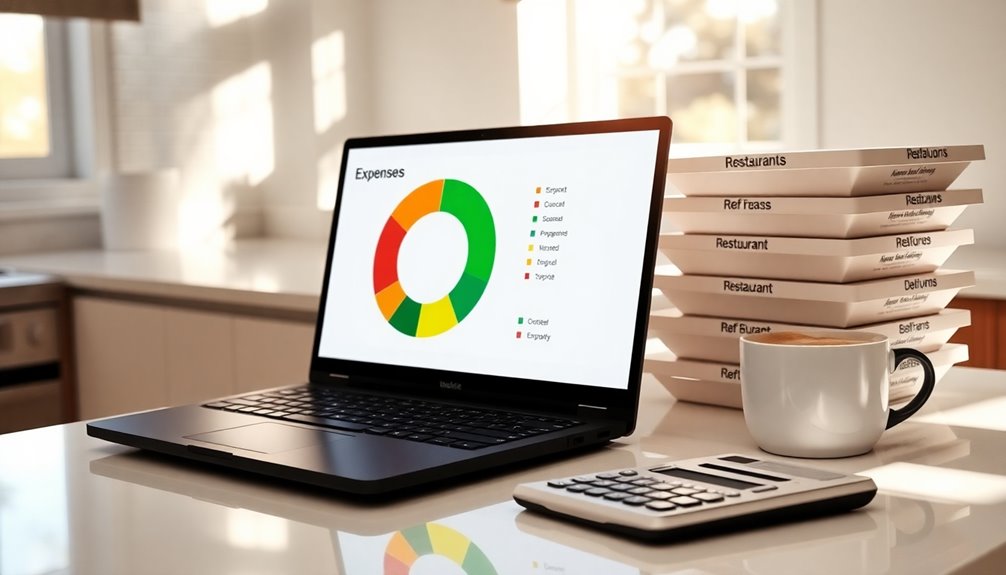To make quarterly taxes painless, start by setting up a system to track your income and expenses consistently. Use IRS worksheets and reliable software to estimate your tax liability accurately. Schedule your payments in advance through electronic options like IRS Direct Pay and set reminders to stay on track. Regularly review and adjust your estimates based on your earnings. Keep going, and you’ll discover how to stay stress-free and compliant throughout the year.
Key Takeaways
- Keep detailed records of all income and expenses to simplify accurate tax estimation and filing.
- Use IRS worksheets or tax software to regularly estimate and adjust quarterly tax payments.
- Automate payments via IRS Direct Pay or EFTPS and set reminders to meet deadlines easily.
- Review income and expenses quarterly to refine estimates and prevent unexpected tax liabilities.
- Maintain organized records and set aside funds periodically to ensure smooth, penalty-free payments.
Establishing a Consistent Income and Expense Tracking System
Establishing a consistent income and expense tracking system is essential for managing your business finances effectively. By keeping organized receipts management, you ensure all business-related purchases are documented, making it easier to categorize expenses accurately. Use clear expense categories like office supplies, travel, or marketing to identify spending patterns and uncover potential savings. Regularly recording each transaction, whether cash, online, or credit, keeps your records up to date and reduces errors. Separating personal and business finances prevents confusion during tax time and helps you claim all eligible deductions. Adopting a routine for daily tracking builds good habits, simplifies reconciliation, and provides real-time insights into your cash flow. Utilizing expense management software like Expensify can automate many of these tasks, saving you hours weekly. Sticking to consistent processes makes managing your finances less stressful and more accurate. Additionally, understanding your dreams of falling can sometimes reflect underlying stress or insecurity about financial stability, emphasizing the importance of organized financial habits.
Calculating Accurate Tax Estimates Using IRS Worksheets and Software

To guarantee your quarterly tax payments are accurate, you need to carefully calculate your estimated taxes using IRS worksheets and reliable software tools. IRS Form 1040-ES provides worksheets that help you estimate your payments by accounting for your total expected income, deductions, and self-employment tax. Applying effective tax deduction strategies reduces your taxable income, lowering your overall liability. Using software automates these calculations, ensuring you incorporate the latest tax brackets and deduction rules, which helps prevent estimated tax penalties. The process involves estimating your income, subtracting allowable deductions, calculating income tax and self-employment tax, then dividing the total by four. Regularly revising your estimates with these tools improves accuracy, making quarterly payments more straightforward and reducing the risk of underpayment. Understanding quarterly deadlines and staying organized throughout the year also play a crucial role in maintaining accurate estimates and avoiding penalties. Additionally, understanding the importance of tax planning can help you make smarter financial decisions and avoid surprises at tax time.
Scheduling and Making Timely Quarterly Payments

Scheduling and making your quarterly payments on time is essential to stay compliant with IRS requirements and avoid penalties. Set up payment reminders a few days before each deadline using digital calendars or accounting apps to prompt early preparation. Automate your payments via IRS Direct Pay or EFTPS, which allows you to schedule in advance and receive confirmation, ensuring timeliness. Record keeping plays a vital role—maintain detailed logs of payment dates, amounts, confirmation numbers, and receipts, whether electronically or in physical files. This organized record keeping helps prevent missed deadlines and provides proof of compliance if needed. Effective record keeping is crucial for maintaining accurate documentation and avoiding discrepancies. According to IRS guidelines, regularly review your payment history, and set aside funds throughout the quarter to avoid scrambling near deadlines. These practices keep your quarterly payments smooth and stress-free.
Reviewing and Adjusting Your Estimates for Future Quarters

Regularly reviewing and adjusting your quarterly tax estimates is essential, especially as your income fluctuates throughout the year. This practice enhances tax audit preparedness and helps you avoid IRS penalties for underpayment. Use tools like IRS Form 1040-ES worksheets, tax estimator software, or accounting platforms such as QuickBooks to recalculate estimates based on current income and expenses. Update your projections each quarter, considering income spikes or dips, so payments stay aligned with your actual earnings. Maintaining accurate estimates prevents large, unexpected tax bills and preserves cash flow. Establish a routine to review your income and expenses regularly, keeping detailed records and adjusting estimates promptly. Accurate estimates help you stay compliant and reduce the risk of penalties. This disciplined approach minimizes penalties and keeps your finances predictable, ensuring you’re always prepared for tax season. Additionally, understanding your contrast ratio and how it affects image quality can help you select the right projector if you plan to set up a home office or entertainment area, making your workspace or leisure space more enjoyable and efficient.
Frequently Asked Questions
How Do I Handle Unexpected Income Spikes During the Year?
When unexpected income spikes happen, you need to update your tax planning and income forecasting. Recalculate your estimated quarterly taxes using IRS Form 1040-ES and pay any additional amount promptly. Keep detailed records of the increase, adjust your profit and loss statements, and consider setting aside extra funds in a separate tax account. Staying proactive helps you avoid penalties and manage your self-employment taxes effectively throughout the year.
What Should I Do if I Miss a Quarterly Payment Deadline?
If you miss a quarterly payment deadline, act quickly to reduce penalties. Calculate what you owe, including interest, and make the payment as soon as possible. Consider requesting a penalty waiver or filing an extension if necessary. Be proactive by adjusting your remaining payments, and consult a tax professional for guidance. Prompt action helps minimize penalties, interest, and the risk of IRS audits.
How Can I Estimate Taxes if My Income Varies Month to Month?
Think of your income as a sailing ship steering unpredictable waters. To stay on course, you need steady income forecasting and diligent expense tracking. By breaking your year into periods, calculating your AGI, and adjusting quarterly estimates, you keep your finances balanced despite the ebb and flow. This approach helps you project taxes accurately, ensuring you pay what’s owed without overburdening yourself during high or low income months.
Are There Penalties for Overpaying Quarterly Taxes?
You might wonder if there are tax penalties for overpaying quarterly taxes. The good news is, overpayment refunds are common, and the IRS doesn’t penalize you for paying too much. Penalties mainly target underpayment or late payments. Overpaying just means you’ll get a refund or credit, so it’s a safe way to avoid tax penalties, especially if your income varies and makes accurate estimates tricky.
Can I Adjust My Quarterly Payments if I Take a Hiatus From Work?
Imagine your business as a ship sailing smoothly; when you hit calmer waters or take a break, you can adjust your course. Similarly, if you take a hiatus, you can revise your payment schedule flexibility by recalculating your estimated taxes using tax deduction strategies. This way, you won’t pay more than necessary, keeping your payments aligned with your current income and avoiding penalties during your downtime.
Conclusion
By following this 4-step system, you can streamline your quarterly taxes and avoid penalties. Did you know that 40% of self-employed individuals face IRS penalties for missed or late payments? Staying consistent with tracking, estimating, scheduling, and adjusting guarantees you stay compliant and stress-free. Make these steps a habit, and you’ll keep your business running smoothly—tax time will become just another quarterly check-in, not a headache.









